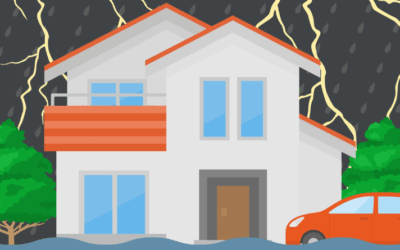With household budgets stretched by rising living costs, many homeowners are looking for ways to reduce expenses. One area that often gets scrutinised is home insurance, with some homeowners tempted to lower their coverage limits or increase excess amounts to reduce premiums. However, being underinsured on your home is expensive when disaster strikes, with the hidden costs far exceeding any short-term savings.
The Scale of the Problem
Recent industry analysis reveals that the majority of UK homes carry some level of underinsurance. This persistent issue affects properties across the country, with many homeowners completely unaware they’re at risk until they need to make a claim.
Home insurance costs have risen dramatically, with the average premium increasing by 14% year-on-year in the final quarter of 2024, reaching £225. This represents a significant jump from £197 in the same period the previous year. Regional variations are stark, with Northern Ireland seeing increases of 31% and London experiencing rises of 25%.
Understanding Home Underinsurance
Buildings Underinsurance: This occurs when your sum insured is less than the full cost of rebuilding your home from scratch. Crucially, rebuilding costs bear no relation to your property’s market value. Rebuilding involves demolition, site clearance, architect fees, planning applications, and construction using modern materials that comply with current building regulations.
Contents Underinsurance: Many homeowners drastically underestimate the replacement value of their possessions. When you add up furniture, appliances, electronics, clothing, books, kitchenware, and personal items throughout your home, the total often reaches surprising levels that exceed policy limits.
Alternative Accommodation Underinsurance: If your home becomes uninhabitable, you’ll need somewhere to live during repairs. Hotel costs, rental properties, storage fees, and additional living expenses can accumulate rapidly, especially if rebuilding takes months rather than weeks.
When underinsurance is discovered during a claim, the consequences extend far beyond receiving a reduced payout. The “average clause” means insurers can reduce all settlements proportionally based on your level of underinsurance.
Consider this scenario: Your home would cost £400,000 to rebuild, but you’ve only insured it for £250,000—meaning you’re 37.5% underinsured. When a kitchen fire causes £40,000 of damage, your insurer will only pay 62.5% of the claim, leaving you with a £15,000 shortfall. This penalty applies to every claim, regardless of size.
Even minor incidents like burst pipes or storm damage can result in substantial out-of-pocket expenses that many families simply cannot afford.
Beyond the Immediate Costs
Home underinsurance creates problems that extend well beyond immediate repair bills:
Family Disruption: Insufficient funds may force you to accept lower-quality repairs or delay restoration work, extending the time your family spends in temporary accommodation or living with damage.
Emotional Stress: Discovering underinsurance during an already traumatic experience like fire or flood damage adds enormous stress to families trying to rebuild their lives.
Long-term Property Issues: Cutting corners on repairs due to funding shortfalls can create ongoing problems that affect your home’s safety, comfort, and future value.
Financial Strain: Unexpected large expenses can devastate household budgets, affect credit ratings, or force families into debt.
The Hidden Costs Homeowners Miss
Many homeowners focus solely on the basic rebuilding structure but overlook significant additional costs:
Professional Fees: Architects, structural engineers, project managers, and planning consultants can add 15-20% to total rebuilding costs.
Site Preparation: Demolition, debris removal, and site clearing often cost more than expected, particularly for older properties with complex foundations.
Modern Standards: New builds must comply with current building regulations, energy efficiency requirements, and accessibility standards that didn’t exist when your home was originally constructed.
Temporary Accommodation: Extended hotel stays or rental properties during rebuilding can cost hundreds of pounds per week for months.
When to Review Your Coverage
Home insurance should be reviewed annually, with immediate reassessment after significant changes:
- Home improvements, extensions, or conversions
- Installation of expensive fixtures, fitted kitchens, or bathrooms
- Acquisition of valuable items like jewellery, art, or specialist equipment
- Changes in local construction costs or building regulations
- Major infrastructure projects affecting your area
Making the Right Choice
Having the right home insurance protects your family’s most valuable asset and financial security. While higher premiums may strain monthly budgets, they’re insignificant compared to the potential costs of underinsurance.
Regular professional valuations, annual policy reviews, and honest assessment of your coverage needs mean your family can face the future with confidence, knowing they’re properly protected against life’s uncertainties.



